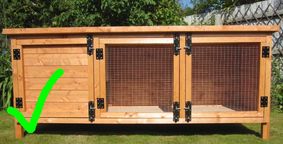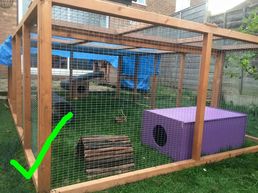Securing outdoor housing
We have seen so many different variations of housing over the years, this guide is to help you ensure your rabbit is truly safe and secure. Many store-bought set ups we would not consider secure and would need extra work from you to fix them up. Have a read below and find out how!
Bolts
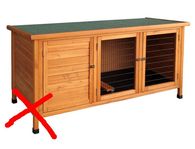 Small central locks, not strong enough
Small central locks, not strong enough
If you have a hutch in particular, look at how the door is secured. If you have a catch which turns, either a plastic/metal catch, a block of wood or a heart-shaped bit of plastic, this is NOT secure! A fox could easily bat this open. Rabbits learn to shake their door to get them loose. And it’s definitely not secure from human trespassers.
Your hutch may have a small central bolt that closes in the centre of the door. This isn’t secure! And will often move so it’s hard to close and deteriorate in the weather. These bolts in the centre of the door are not safe as a determined dog or fox could push and pull the bottom corner and eventually knock it in, especially if the wood is weak or thin. Bolts should be placed at both the top and bottom of the doors to prevent this possibility.
Bolts on hutches, and indeed any outdoor housing, must be large padbolts or tower bolts. These are chunky so easy to use with frozen fingers, weather proofed so less risk of rust, and padbolts have the option to put a proper padlock on so also a deterrent to human trespassers. These bolts are available from any good hardware store.
Your hutch may have a small central bolt that closes in the centre of the door. This isn’t secure! And will often move so it’s hard to close and deteriorate in the weather. These bolts in the centre of the door are not safe as a determined dog or fox could push and pull the bottom corner and eventually knock it in, especially if the wood is weak or thin. Bolts should be placed at both the top and bottom of the doors to prevent this possibility.
Bolts on hutches, and indeed any outdoor housing, must be large padbolts or tower bolts. These are chunky so easy to use with frozen fingers, weather proofed so less risk of rust, and padbolts have the option to put a proper padlock on so also a deterrent to human trespassers. These bolts are available from any good hardware store.
Mesh & Wire
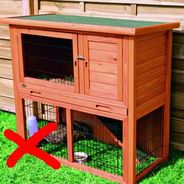 Small inadequate central lock, bars and no mesh (and too small a hutch!)
Small inadequate central lock, bars and no mesh (and too small a hutch!)
Most hutches now come with welded mesh as standard. Never, ever, ever, use chicken wire on hutches or runs. It is not secure as rabbits can chew out of it, and foxes can chew in! We recommend a really good quality welded mesh with ideally no larger than 0.5” (1.27cm) holes. If the holes are too large, foxes or dogs can get their teeth in and shake it, and it will let mice and rats in! A 16 gauge wire mesh is a good one to use also, it's tougher stuff than larger gauges (19, 22 etc).
There are some hutches which come with thicker metal bars. This idea is ok but we have yet to see a hutch with this which is actually large enough for rabbits! They are also more prone to rust and the gaps may well be large enough to let mice in.
For runs, we strongly recommend a heavy wood and welded mesh style run or aviary, and not the all metal ones. You want a run that predators, people and the weather can’t move around. All-metal runs often need to be fixed well into the ground so they can’t be pulled about or blown around. Often the gaps in the bars are too wide and will allow rats and mice in, and for cheaper all metal runs, there have been horror stories of rabbits getting their heads stuck and breaking their necks! All metal runs can be ok for exercise time which is 100% supervised by their owners, but should not be used unsupervised. All runs should have a solid secure roof. Remember YOU need to be able to get into the run and move around to catch rabbits, so don’t forget that! We recommend having human-sized walk in gates for easy access.
There are some hutches which come with thicker metal bars. This idea is ok but we have yet to see a hutch with this which is actually large enough for rabbits! They are also more prone to rust and the gaps may well be large enough to let mice in.
For runs, we strongly recommend a heavy wood and welded mesh style run or aviary, and not the all metal ones. You want a run that predators, people and the weather can’t move around. All-metal runs often need to be fixed well into the ground so they can’t be pulled about or blown around. Often the gaps in the bars are too wide and will allow rats and mice in, and for cheaper all metal runs, there have been horror stories of rabbits getting their heads stuck and breaking their necks! All metal runs can be ok for exercise time which is 100% supervised by their owners, but should not be used unsupervised. All runs should have a solid secure roof. Remember YOU need to be able to get into the run and move around to catch rabbits, so don’t forget that! We recommend having human-sized walk in gates for easy access.
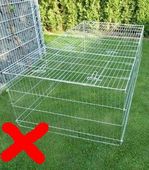 All-wire pen, not secure & risk of rabbit getting stuck
All-wire pen, not secure & risk of rabbit getting stuck
If the run or aviary is on grass, we recommend digging down a few inches, laying some good quality galvanised welded mesh, and filling back in with earth and turf so your rabbits cannot dig out, but still can enjoy grass, and no predators can dig in. We don’t recommend having the mesh visible so the rabbits are hopping about on it, it can be uncomfortable for them and there’s a risk they may catch their claws in it.
We recommend regularly checking your mesh for any areas of deterioration and fixing and stapling where necessary. Foxes have been known to work on areas of mesh and coming back night after night until the mesh gives way. This can be on corners or on mesh lids which can be jumped up and down on, so make sure everything is always solid and secure.
If you have dogs or cats, or know you're in a foxy area but indoor rabbits are not an option, there are some extra steps you can take. These include double meshing all mesh - so you have the usual mesh fixed to the inside of the wood, put a second strong mesh on the outside also. And 1-2ft strong solid wood kick boards along the bottom of the run also help as it means predators cannot sneak up as easily and the rabbits will not feel so watched from outside their enclosure.
We recommend regularly checking your mesh for any areas of deterioration and fixing and stapling where necessary. Foxes have been known to work on areas of mesh and coming back night after night until the mesh gives way. This can be on corners or on mesh lids which can be jumped up and down on, so make sure everything is always solid and secure.
If you have dogs or cats, or know you're in a foxy area but indoor rabbits are not an option, there are some extra steps you can take. These include double meshing all mesh - so you have the usual mesh fixed to the inside of the wood, put a second strong mesh on the outside also. And 1-2ft strong solid wood kick boards along the bottom of the run also help as it means predators cannot sneak up as easily and the rabbits will not feel so watched from outside their enclosure.
Wood
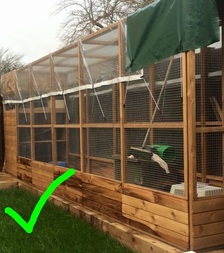 Wood run with good mesh, secure kick boards and places to hide (outdoor exercise run for indoor rabbits)
Wood run with good mesh, secure kick boards and places to hide (outdoor exercise run for indoor rabbits)
We recommend all-wood housing for outdoor hutches, playhouses, aviaries and sheds. We do not recommend plastic hutches or sheds as these are too hot in summer and too cold in winter.
Brick built structures can work, but must have good ventilation and large windows for light, they would also need insulating as brick sheds and garages can be very cold in winter. We would want a brick built structure to have permanent access to a secure outdoor run.
It’s a good idea to lay non-slip lino on the floors of hutches and sheds as this will protect them from bunny pee and be easier to clean and disinfect. Remember rabbits need very large bedroom areas, not offered in standard hutches. Sheds or playhouses are better for this reason.
Ideally hutches and sheds should be either of shiplap or tongue and groove construction. Overlap construction is the cheapest but they are that for a reason and will deteriorate much more quickly and be far more drafty. Plywood should also be used with caution, it often forms the back, the flooring or any interior walls of hutches, it is prone to warping, especially if it gets damp, and over time will need replacing. It’s easily chewed too. MDF should never be used in animal housing as it’s poisonous if chewed. All solid wood construction is better!
Of course it is extremely important to check over your housing daily for any damage or signs of leaks, rot or mould, especially when there has been poor weather, and also to look for signs of rabbits chewing on the inside, or predators chewing on the outside. Any damage should be acted on immediately to avoid escapes or health problems.
Roofing felt may need to be changed every few years and the wood should be treated with animal-safe wood weather treatment. Both Cuprinol Garden Shades and Wilkinsons wood treatment paints are bunny safe.
Check out our recommended housing suppliers for housing we approve of!
If you have any queries about your own housing, please do not hesitate to contact us.
Brick built structures can work, but must have good ventilation and large windows for light, they would also need insulating as brick sheds and garages can be very cold in winter. We would want a brick built structure to have permanent access to a secure outdoor run.
It’s a good idea to lay non-slip lino on the floors of hutches and sheds as this will protect them from bunny pee and be easier to clean and disinfect. Remember rabbits need very large bedroom areas, not offered in standard hutches. Sheds or playhouses are better for this reason.
Ideally hutches and sheds should be either of shiplap or tongue and groove construction. Overlap construction is the cheapest but they are that for a reason and will deteriorate much more quickly and be far more drafty. Plywood should also be used with caution, it often forms the back, the flooring or any interior walls of hutches, it is prone to warping, especially if it gets damp, and over time will need replacing. It’s easily chewed too. MDF should never be used in animal housing as it’s poisonous if chewed. All solid wood construction is better!
Of course it is extremely important to check over your housing daily for any damage or signs of leaks, rot or mould, especially when there has been poor weather, and also to look for signs of rabbits chewing on the inside, or predators chewing on the outside. Any damage should be acted on immediately to avoid escapes or health problems.
Roofing felt may need to be changed every few years and the wood should be treated with animal-safe wood weather treatment. Both Cuprinol Garden Shades and Wilkinsons wood treatment paints are bunny safe.
Check out our recommended housing suppliers for housing we approve of!
If you have any queries about your own housing, please do not hesitate to contact us.

